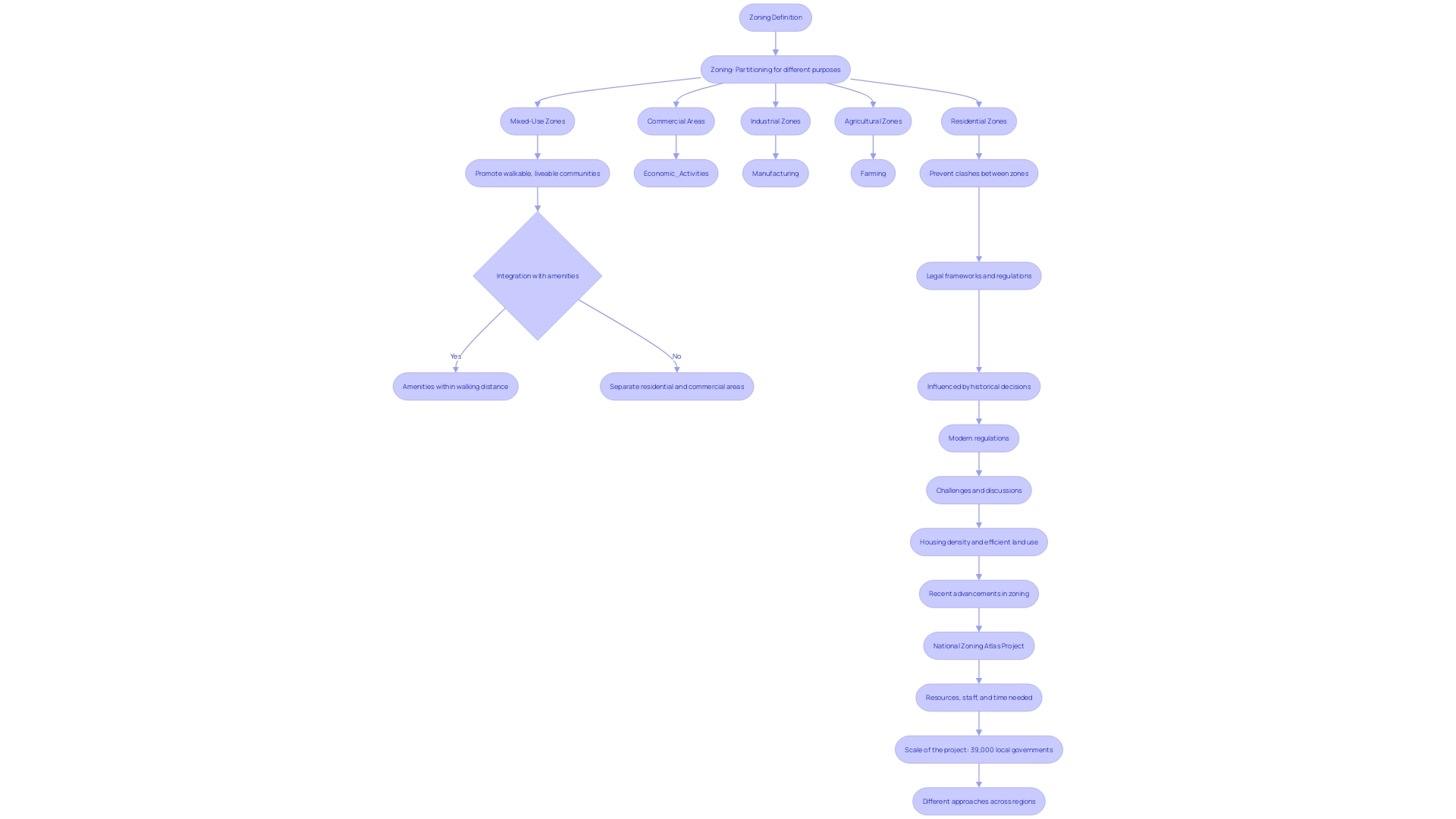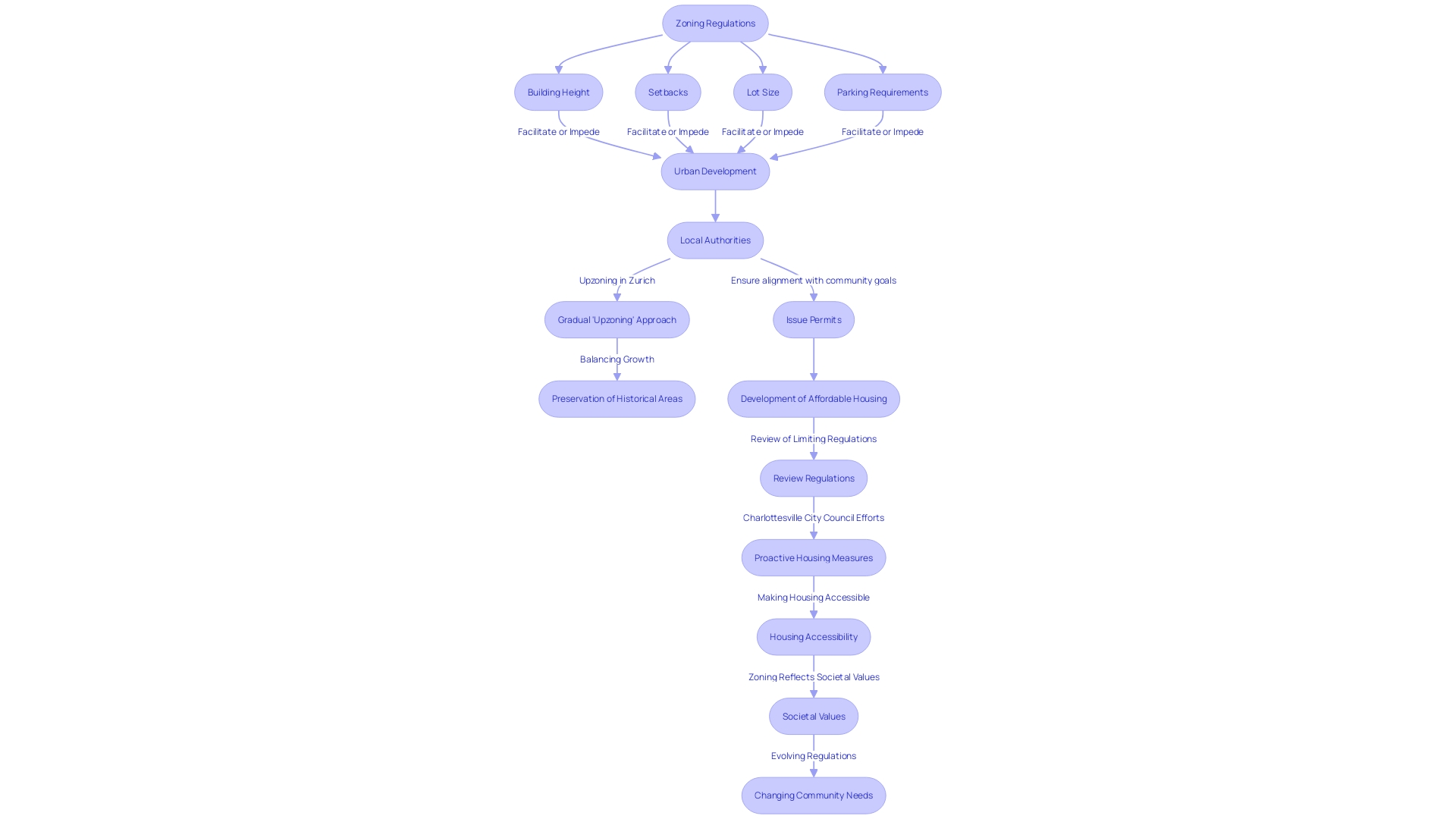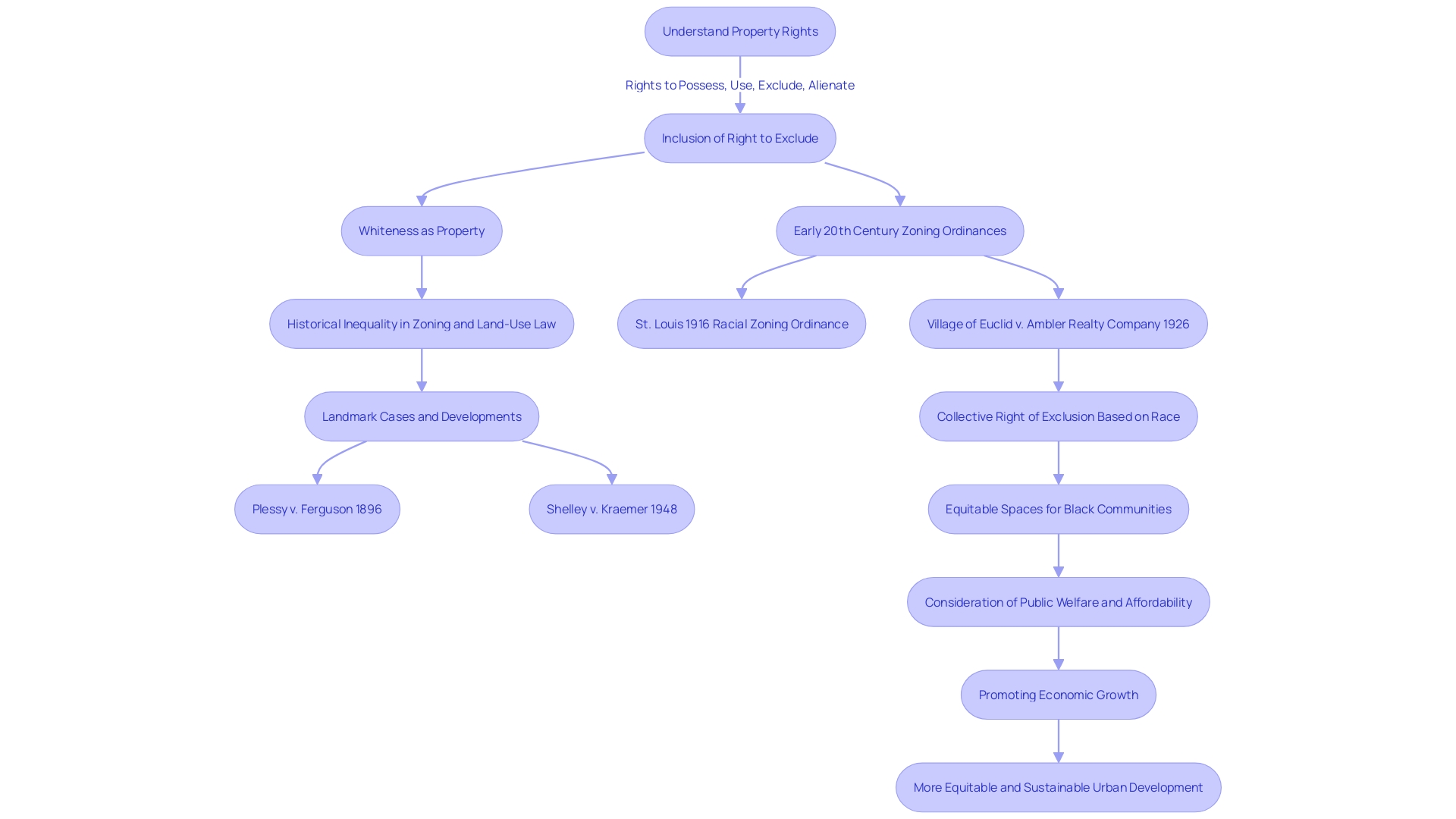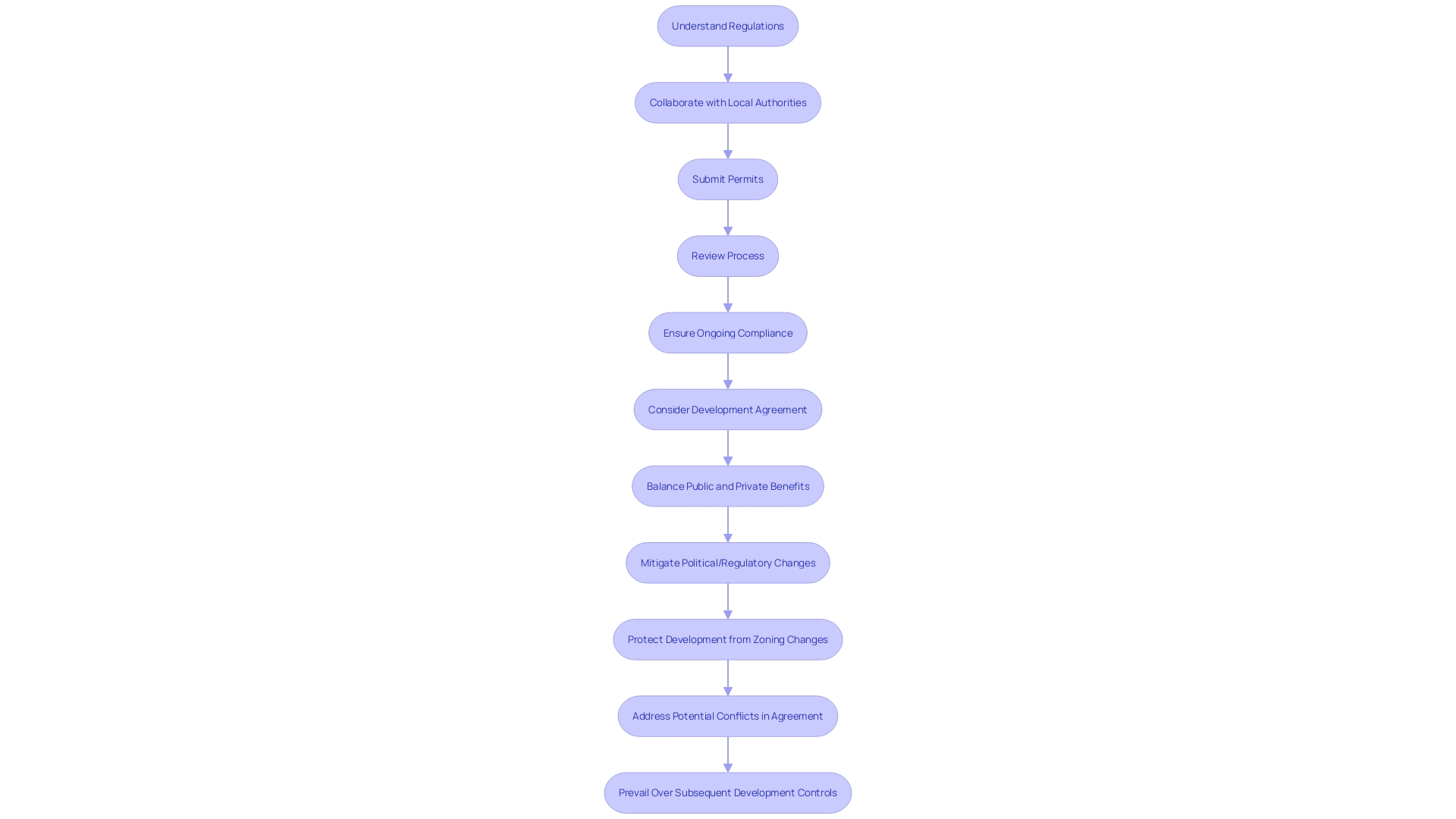Introduction
Land zoning serves as a fundamental framework by which local governments manage and direct development and land use in their areas. It categorizes land into sectors with designated permissible uses, ensuring that each piece of land contributes positively to the community and its environment. Zoning ordinances maintain the integrity of residential neighborhoods, prevent industrial encroachment, and preserve green spaces.
However, the complexities of urban development and its impact on zoning are evident, with California's experience highlighting the need for comprehensive land use reform. This reform is viewed not just as a housing or economic issue, but also as a crucial climate action strategy. The transformation of zoning policies can yield numerous societal benefits, including reduced carbon emissions, increased housing affordability, and enhanced public health outcomes.
Understanding zoning is crucial for land acquisition professionals to navigate the dynamics and influence the availability and suitability of land for development projects.
What is Land Zoning?
Territory classification serves as a crucial framework by which local governments manage and direct development and land utilization in their areas. It categorizes land into sectors with designated permissible uses, ensuring that each piece of land contributes positively to the community and its environment. For example, land use regulations maintain the integrity of residential neighborhoods, prevent industrial encroachment, and preserve green spaces.
The complexities of urban development and its impact on land use regulations are evident in California's experience. With a vast population spread over numerous municipalities, California's land use data reveals a patchwork of policies affecting 473 cities and towns as well as 46 unincorporated areas. The state's approach emphasizes the need for comprehensive utilization reform, which is increasingly regarded not just as an economic or environmental issue, but also as a crucial climate action strategy. Urban sprawl, after all, accounts for roughly a third of global greenhouse gas emissions, in part due to increased travel distances and energy-inefficient buildings.
In this situation, the alteration of land-use policies can produce various societal advantages, such as decreased carbon emissions, improved affordability of residences, and enhanced public health results. For instance, the state of Minnesota has showcased the possibilities of reform through the engagement of diverse voices in the use discussion, leading to significant zoning changes in Minneapolis. These reforms have started to demonstrate initial effects on prices and construction trends.
The Provincial Planning Statement (PPS), 2024 of Ontario, Canada, illustrates the proactive role that government policy plays in shaping land use. It provides policy direction on critical issues like housing progress, economic growth, and environmental protection, reinforcing the principle that municipal decisions should align with these overarching policies. The PPS empowers municipalities to foster sustainable development while safeguarding essential resources and managing risks such as flooding.
Modern land use practices also address underlying concerns of property rights and racial equity. The historical right to exclude, a cornerstone of property rights, has intersected with race to influence land-use laws, reflecting broader societal inequalities. This has ignited a heated discussion over the fairness and constitutionality of regulations that restrict landowners' control over their property. Therefore, the discussion regarding land use is not just about the regulation of land but also about individual freedoms and social equity.
The economic consequences of land use regulations are also substantial. With a substantial portion of renters experiencing financial burden due to accommodation costs, the availability of affordable housing is a pressing concern. Current regulations often worsen this challenge by restricting the construction of new housing units, thereby impeding efforts to address the housing supply shortage.
In summary, zoning is more than a mere technical aspect of urban planning; it is a tool that showcases our values and priorities regarding property rights, social equity, environmental sustainability, and economic growth. It is vital for professionals involved in acquiring property to comprehend these dynamics and how they impact the accessibility and appropriateness of terrain for projects.
Types of Zoning
Zoning classifications serve as the urban planner's blueprint, delineating the permitted uses for different parcels of land to ensure orderly development and prevent conflicts between diverse land uses. These classifications include residential areas, typically earmarked for homes and apartment complexes, commercial zones for businesses and retail ventures, industrial zones for manufacturing centers and warehouses, and agricultural zones for farming activities.
Each land use category has its nuances, influenced by historical decisions and contemporary legal frameworks. For instance, the significant 1926 Supreme Court decision in Village of Euclid v. Ambler Realty Co. affirmed the legality of land use regulation. This decision supports the modern regulations that control land use today, reflecting America's foundational principle that property rights include the right to use one's property.
Recent advancements emphasize the ever-changing character of land use regulations. In December 2023, Charlottesville's City Council passed a comprehensive revision of the city's regulations to facilitate the construction of more residential units, part of the wider Cville Plans Together initiative aimed at increasing affordable living spaces. This overhaul indicates a shift towards more flexible land use practices, aligning with the burgeoning demand for housing and evolving urban landscapes.
Nevertheless, land use practices can also present challenges, such as those imposed by the International Building Code (IBC). While the IBC is primarily an American standard, its requirements, such as mandating two staircases for buildings over three stories, can significantly constrain the design and density of new constructions on small urban lots, like those in San Francisco. This illustrates the tension between building codes and the need for more efficient land use in dense urban environments.
The push and pull between development, urban planning, and zoning regulations are also evident in the discussion around small residential buildings under the IBC. The code's restrictions can stymie the construction of smaller-scale residences, which is crucial for adding density on compact urban plots. As cities like San Francisco move to rezone to accommodate more housing, there's a growing conversation about updating building codes to be more conducive to smaller, more efficient residential projects.
Understanding the multifaceted role of zoning in the use and progress of property is crucial for those navigating the complexities of ownership rights and urban planning. With the evolving landscape of zoning regulations and their significant impact on land use, staying informed about these changes is more important than ever for ensuring successful property improvement and management.

How Zoning Works
Zoning is not merely a set of guidelines; it's an intricate system that shapes the urban landscape and impacts affordability and accessibility of housing. Regulations governing building height, setbacks, lot size, and parking are more than bureaucratic stipulations; they are instruments that can either facilitate or impede the development of communities. Local authorities, such as boards that regulate land use and planning departments, bear the responsibility of ensuring that these regulations align with broader community goals and issue permits accordingly.
In reality, the impact of land use regulations can be observed in the case of the Canton of Zurich in Switzerland, where gradual 'upzoning' permitted slight enhancements in residential density, like appending an extra level to a three-story structure. This approach, while deliberate and gradual, reflects an understanding of the need to balance urban growth with the preservation of historical areas.
Furthermore, the pressing requirement to tackle affordability in the accommodation sector is becoming more and more evident. With almost 50% of all rental households in the U.S. deemed cost-burdened and the pursuit of homeownership becoming increasingly difficult because of escalating expenses, there is an urgent requirement to review regulations that may limit the development of additional affordable living alternatives.
The recent initiative by the Charlottesville City Council to revamp its rules regarding land use exemplifies proactive efforts to make housing more accessible. By approving the Development Code, the council has taken a significant step towards creating a framework that encourages the construction of affordable living spaces.
When we analyze the intricacies of urban planning regulations, it becomes evident that it covers a wide range of aspects beyond just the utilization of space. Zoning is a reflection of our societal values, representing a balance between individual property rights and the collective interests of the community. It is a government-crafted plan that dictates where we live, work, and play, and it is essential that these regulations evolve in response to the changing needs of our communities.

Who Controls Zoning?
Local authorities, including city councils and county commissions, are responsible for establishing ordinances that regulate land use within their jurisdiction. These ordinances serve to regulate growth in line with the community's aspirations and the property rights of owners. Public hearings and stakeholder engagement are integral to this process, ensuring a democratic approach to urban planning. The intricacies of land use regulations and their effects on the affordability and growth of residential buildings are well-documented. For example, California's policies that only allow single-family homes in its various municipalities emphasize the difficulties associated with diverse and extensive land use regulations.
The effect of land use regulation revisions on dwelling availability and prices has been examined, demonstrating that despite legal and regulatory modifications, the rise in residential supply is frequently minimal. For example, the Urban Institute found that relaxing use restrictions resulted in a provision increase of only 0.8% within 3 to 9 years. In Minneapolis, a city of 425,000, reform in land use regulations was achieved through a robust discourse on housing equity, environmental issues, and racial justice. The city's efforts have become a case study for other municipalities, including New York State and New York City, as they consider their own use reforms.
Furthermore, the legal environment surrounding land use reforms is changing. Legal challenges and the use of judicial tools by opponents have been met with informed strategies by planners and advocates. Brian J. Connolly, a specialist in real estate, land use, and the laws related to the growth and improvement of properties, has made notable contributions to this area, offering guidance on maneuvering through the complexities of reforms related to land use regulations.
Recent news from Charlottesville, Virginia, highlights the continuous development of land use regulations. The city council approved a comprehensive revamp of land use laws to facilitate the construction of more affordable housing units, demonstrating active efforts to balance development with affordability.
The requirement for land use regulation modification is emphasized by troubling statistics concerning the cost of living. The U.S. Census Bureau reports that nearly half of all rental households are burdened by the cost of rent, with many spending over 50% of their income. Homeownership is equally challenging, with the average monthly cost of owning a median-priced home reaching $3,000, as per a Harvard University study.
The fundamental concepts of property rights in the United States, which encompass inherent rights to life, freedom, and property, influence the framework in which land use regulations function. These rights underpin the expectation that property use should not be unduly constrained by government regulation. The core of land use planning is, therefore, to harmonize individual property rights with the collective vision for community development, emphasizing the complex relationship between private property ownership and public regulatory power.
Why is Zoning Important?
Zoning serves as the foundational framework of urban planning, delineating use to shape the urban fabric of cities and towns. This intricate tapestry consists of streetscapes, buildings, and infrastructure that collectively dictate the physical experience of an area. Through the classification of districts to separate residential, commercial, and industrial areas, the process of categorizing helps to prevent conflicts between incompatible land uses, thereby maintaining the character and quality of communities. It addresses potential issues like noise, traffic, and pollution, protecting the living environment and property values. Moreover, the allocation of areas for business activities encourages economic growth, which in turn can attract investments and create employment opportunities.
Considering the development of land use regulations in the United States, the notion of 'public welfare', which has traditionally supported restrictions on land use, is currently under examination for its subjective character and influence on the affordability of residences. A more objective 'base code' is proposed to replace preference-based regulations, aiming to alleviate the housing crisis. Communities like Georgetown in Washington, DC, offer a glimpse of the potential of land use regulations to cultivate livable, walkable neighborhoods rich in history and diversity, suggesting a shift towards more equitable and sustainable urban development.
In the end, the process of land use planning is a dynamic tool, embodying the intent to strategically guide community growth. As urban areas like Winnipeg's Glenwood neighborhood grapple with the challenges of infill and evolving landscapes, the core purpose of land use regulations remains to provide a blueprint for harmonious living, work, and recreation, maintaining the balance between individual property rights and the collective good.

Understanding Zoning Classifications
Understanding the potential uses of your property requires navigating the complexities of zoning classifications. Zoning dictates land use and is a critical element of urban planning. It ensures that the development of parcels is systematic, preventing conflicts between new and existing districts. For example, consider Zurich, Switzerland, where land use regulations were gradually changed to permit additional residential units, like the inclusion of an additional level to a three-story residence, particularly in the vicinity of the historic city center. In California, data on land use planning was analyzed for a vast majority of municipalities, revealing the intricate patchwork of land use planning. Zoning classifications have wide-ranging implications, from restricting commercial and industrial developments to impacting affordable housing availability. In some cases, they even govern the minutiae of day-to-day life, designating where one can live, work, and relax. To stay updated on such regulations, one must review the local ordinance or code, as it varies by municipality. It's important to be involved in the process, as observed in Guelph, where public input on land use amendments is requested with clear deadlines for submissions. Understanding land use regulations is not just about compliance; it's about recognizing your property rights within the framework of government-crafted boundaries.
How to Find Your Property's Zoning Designation
Identifying the classification for the use of your property is an essential part of property development and utilization. Your nearby planning department or zoning authority acts as a crucial asset in this procedure, offering information about the specific classification of your property. Furthermore, official land use maps and internet resources provided by your local government can help you obtain a thorough comprehension of the allowed applications and limitations that pertain to your property. Given the historical importance of land use regulation, dating back to the crucial Supreme Court ruling in the Village of Euclid vs. Ambler Realty Co., it's clear that the practice of zoning plays a fundamental role in urban planning. Acquiring accurate information about land use is crucial to ensure adherence to local regulations and to promote sustainable initiatives that align with the community's vision and legal structure.

Key Steps to Follow Zoning Laws
Understanding and complying with regulatory restrictions is a crucial undertaking for property advancement. Start by familiarizing yourself with the specific land use regulations that apply to your property, such as the types of buildings permitted, setback regulations, and height restrictions. If you're planning a development, it's crucial to collaborate with local planning authorities to ensure your project aligns with the code for land use. The submission of all required permits and undergoing the review process will secure the necessary approvals. Once permits are granted, strict compliance with the approved plans and any ongoing land use obligations is mandatory.
Real-world examples, like the incremental 'upzoning' in Zurich, Switzerland, illustrate the careful balance between growth and regulation. This approach allowed for modest density increases while respecting historic preservation. In contrast, Charlottesville, Virginia, demonstrated a proactive stance in revising their regulations to facilitate more affordable housing opportunities.
Zoning's complexity is evident in the diverse applications from one jurisdiction to another. While some zones may restrict commercial growth, others may encourage it. Development agreements emerge as a strategic tool, setting the terms for both the developer and the government to reap benefits.
The legal framework surrounding property rights dates back to America's founding principles, recognizing the innate right to use one's property. Nevertheless, land use regulation has developed as an essential instrument for urban planning, influencing the sustainable growth of communities. This delicate interplay between individual rights and community planning is a fundamental aspect of land use regulation.
Staying informed about changes in land use regulations is crucial. For example, Guelph's call for public input on by-law amendments related to land use highlights the significance of civic engagement in the planning process. It is a reminder that land use regulation is not only a regulatory mechanism but also a reflection of community values and priorities.
Statistics demonstrate that innovative tools and technologies, like GIS and programming languages such as Python, are crucial in analyzing and interpreting land-use data. These insights are vital for developers, city planners, and policymakers as they navigate the intricacies of land use regulations and their implications for housing supply and affordability.

Common Zoning Districts
Land allocation and use regulations are essential to urban planning, serving as the government's tool for guiding development. Municipalities implement a range of district classifications, each with specific regulations governing allowable uses. Residential zones might be subdivided into single-family, multi-family, and mixed-use categories, while commercial zones could be delineated for offices, retail centers, and other business activities. Industrial districts may be specialized further into light industrial, heavy industrial, and manufacturing sectors. These classifications are designed to preserve the character and intended use of existing districts, avoiding conflicts between different land uses.
For example, in California, with more than 39 million residents and hundreds of municipalities, a thorough examination of land use data unveiled the dominance of single-family-only land use. This category of land use regulation can greatly affect the supply of residences, affordability, and community composition. In Minneapolis, a city of 425,000, reforms were initiated to address affordability, racial equity, and environmental concerns. The reforms sought to integrate underrepresented voices in land use discussions, leading to the construction of more accessible dwelling types without disrupting existing community aesthetics. Minneapolis demonstrates how changes in land use regulations can impact construction and residential costs, offering a model for other regions such as New York State and City.
A recent case in Charlottesville, Virginia, highlights the ever-changing nature of land use laws. The city council approved a significant overhaul of land use regulations to facilitate more affordable housing construction, showcasing how land use decisions can be responsive to community needs and contribute to solving broader societal issues.
Comprehending the intricacies of land use regulations is crucial for property owners and developers alike. The right to use property, a fundamental principle rooted in America's founding philosophy, intersects with modern land use practices, which sometimes impose limitations to address collective community goals. As regulations related to land use evolve, they can either limit or facilitate property growth, influencing the urban environment and real estate markets. Hence, it is crucial to remain updated about local regulations and engage in municipal conversations to guarantee that use policies correspond with the wider community's requirements and principles.
Special Zoning Considerations
Grasping the intricacies of special land use considerations is vital for property owners and developers, as they can greatly affect the utilization and progress of land. These special zones, such as overlay districts, are regulatory tools that local governments apply on top of base zoning to address specific concerns. For instance, historic preservation districts aim to protect the character and heritage of areas with significant historical value. Floodplain districts are created to handle growth in areas susceptible to flooding, thereby minimizing possible harm. Additionally, conservation districts safeguard natural resources by regulating development in environmentally sensitive areas.
The significance of these special zoning considerations was underscored by the reform efforts in Minneapolis, which focused on housing affordability, racial justice, and environmental concerns. This reform also highlighted the engagement of community voices typically marginalized in land use discussions. In Coral Gables, Florida, the struggle of Orlando Capote to protect his family home amidst a substantial project showcases the personal impact zoning regulations can have on property owners.
Recent news from Menlo Park indicates that agreements can play a pivotal role in balancing public and private interests. These agreements, which are contracts between developers and local governments, establish the conditions for a project in exchange for public benefits. With 20% of the residential units in the proposed Willow Park project designated as affordable, this demonstrates how agreements for growth can meet community needs.
Legal challenges to regulations concerning the use of property, as studied by Professor Brian J. Connolly, emphasize the intricacy of regulations and their effect on the affordability of housing and urban revitalization. Zoning is an intricate system that governs property usage, shaping our residential, occupational, and recreational environments. It's vital for those involved in land development to be aware of and navigate these special zoning considerations and development agreements to ensure project success and contribution to community welfare.
Conclusion
In conclusion, land zoning is a crucial framework for managing and directing development and land use. It categorizes land into sectors with designated uses, preserving residential areas, preventing industrial encroachment, and protecting green spaces. Comprehensive land use reform, including zoning policies, is essential for addressing housing affordability, reducing carbon emissions, and improving public health.
Understanding zoning is vital for land acquisition professionals to navigate the availability and suitability of land for development projects. Zoning classifications serve as blueprints, ensuring orderly development and preventing conflicts between land uses. Local authorities establish zoning ordinances and engage in public hearings to ensure a democratic approach to urban planning.
Staying informed about zoning changes and participating in discussions is crucial. Determining the zoning classification of land is essential for successful property development, and collaboration with planning authorities is necessary. Special zoning considerations, such as overlay districts and historic preservation districts, address specific concerns and protect the character of areas.
Development agreements can balance public and private interests and contribute to community needs. Overall, zoning is a dynamic tool that reflects our values and priorities regarding property rights, equity, sustainability, and economic development. Understanding zoning regulations is essential for successful property development and the creation of vibrant and sustainable communities.




